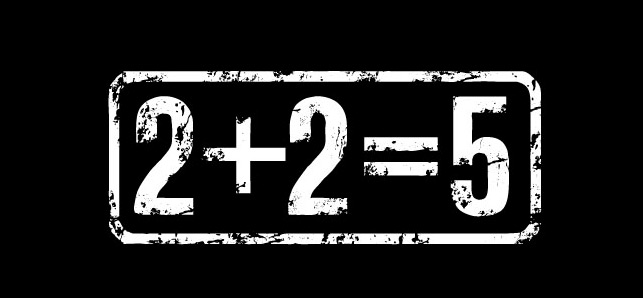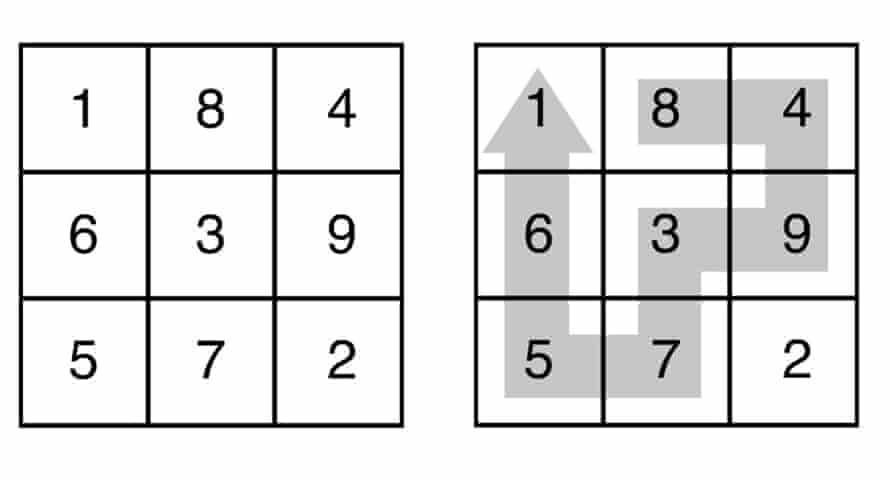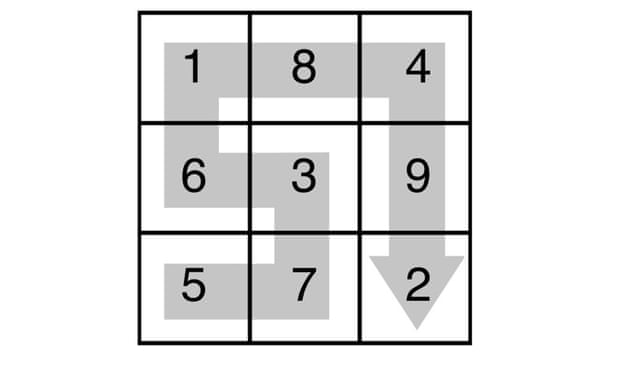Poll
 | 25 votes (49.01%) | ||
 | 16 votes (31.37%) | ||
 | 7 votes (13.72%) | ||
 | 4 votes (7.84%) | ||
 | 12 votes (23.52%) | ||
 | 3 votes (5.88%) | ||
 | 6 votes (11.76%) | ||
 | 5 votes (9.8%) | ||
 | 12 votes (23.52%) | ||
 | 10 votes (19.6%) |
51 members have voted
Quote: ChumpChangeThe photo shows a $100 bill, the question says the student got $2, so how would the teacher get $100?
link to original post
She might have other money in her purse.

Three horses are standing in a triangular field, which is exactly 100 yards on each side. One horse stands at each corner; and simultaneously all three set off running. Each horse runs after the horse in the adjacent corner on his left, thus following a curved course, which terminates in the middle of the field, all three horses arriving there together.
The horses obviously ran at the same speed, but just how far did they run?
Quote: Gialmere
Three horses are standing in a triangular field, which is exactly 100 yards on each side. One horse stands at each corner; and simultaneously all three set off running. Each horse runs after the horse in the adjacent corner on his left, thus following a curved course, which terminates in the middle of the field, all three horses arriving there together.
The horses obviously ran at the same speed, but just how far did they run?
link to original post
Quote: GM200/3 yards.
link to original post
Sorry, incorrect.
Quote: Gialmere
Three horses are standing in a triangular field, which is exactly 100 yards on each side. One horse stands at each corner; and simultaneously all three set off running. Each horse runs after the horse in the adjacent corner on his left, thus following a curved course, which terminates in the middle of the field, all three horses arriving there together.
The horses obviously ran at the same speed, but just how far did they run?
link to original post
BUUUZZZZZZZZ

Exactly 100 yards. This is because at any moment the horses are at the vertices of an equilateral triangle which diminishes at the velocity of the horses. Thus 100/V is the time it takes for the triangle to become a point in the middle of the field. The distance the horses travel during that time is V x 100/V which equals exactly 100 yards.
---------------------------------------
--------------------------------------
Still in play...
Quote: WizardA math professor asks for a volunteer from his class. Somebody volunteers and comes forward. The professor gives the student two $1 bills. Then the following exchange takes place:
Professor: I am about to make a statement. If that statement is false, you will give me back $1. If it is true, you keep both $1 bills. Do you agree?
Student: I agree.
What should the professor's statement be so that the student must pay the professor $100?
I think Ed will especially like this one.
link to original post
Quote: Gialmere
Still in play...Quote: WizardA math professor asks for a volunteer from his class. Somebody volunteers and comes forward. The professor gives the student two $1 bills. Then the following exchange takes place:
Professor: I am about to make a statement. If that statement is false, you will give me back $1. If it is true, you keep both $1 bills. Do you agree?
Student: I agree.
What should the professor's statement be so that the student must pay the professor $100?
I think Ed will especially like this one.
I didn't want to answer this one, as I have seen it before - a variation is in Smullyan's The Riddle of Scheherazade:
You will not keep both bills, nor will you pay me $100.
If the statement is true, then the student keeps both bills - but that makes the statement false. Therefore, the statement must be false.
This means that the student did keep both bills, or paid the professor $100. However, since the statement is false, the student had to give the professor one of the bills, so the only way the statement can be false is if the student pays the $100.
Quote: Gialmere
Exactly 100 yards. This is because at any moment the horses are at the vertices of an equilateral triangle which diminishes at the velocity of the horses. Thus 100/V is the time it takes for the triangle to become a point in the middle of the field. The distance the horses travel during that time is V x 100/V which equals exactly 100 yards.
I disagree.
Quote: Gialmere
Horse: "No."
link to original post
The shape of the curve eludes me. I know it looks familiar and unfamiliar simultaneously.
I can't offer extra credit (beyond bragging rights).
Quote: GMThe path of each horse is a logarithmic spiral.
link to original post
That much I got. ;)
I just don't recognize which one.
Quote: GMQuote: Gialmere
Exactly 100 yards. This is because at any moment the horses are at the vertices of an equilateral triangle which diminishes at the velocity of the horses. Thus 100/V is the time it takes for the triangle to become a point in the middle of the field. The distance the horses travel during that time is V x 100/V which equals exactly 100 yards.
I disagree.The problem is that the side of the triangle decreases at speed 3V/2, because the directions in which the horse are running are always at 120 degrees to each other. Your argument would work if there were 4 horses at the vertices of a square.
link to original post
Yeah, I found the same problem at another puzzle site which agrees with your solve...
Stack Exchange Puzzle Forum
So good show. I just saw it and thought it looked fun and easy, but what do I know? In the gif, the spirals certainly don't appear to be the length of the big triangle sides even assuming infinite rotations.

The year 1978 has an unusual property. When you add the 19 to the 78, the total is the same as the middle two digits (97).
What will be the next year to have this same property?
Quote: GialmereThe year 1978 has an unusual property. When you add the 19 to the 78, the total is the same as the middle two digits (97). What will be the next year to have this same property?
The year 2307.
And then...
2417
2527
2637
2747
2857
Quote: EdCollinsQuote: GialmereThe year 1978 has an unusual property. When you add the 19 to the 78, the total is the same as the middle two digits (97). What will be the next year to have this same property?
The year 2307.
And then...
2417
2527
2637
2747
2857
link to original post
Correct!
Rarer than a solar eclipse.
---------------------------------------------------

Using only two 2's and any combination of mathematical signs, symbols and functions can you make 5?
Quote: Gialmere
Using only two 2's and any combination of mathematical signs, symbols and functions can you make 5?
link to original post
(sec(arctan(2))^2
Quote: chevy
(sec(arctan(2))^2
link to original post
Wow, that is so weird, that is indeed exactly 5. See derivation, in spoiler.
we know that:
1+tan2(y) = sec2 (y)
now define x= tan(y) and plug that into the left side of the equation
thus, y=arctan(x) and plug that into the right side of the equation.
We are left with:
1 + x2 = sec2 (arctan(x))
and that's a general formula for x2 + 1; its the sec2 (arctan(x)) !!!!
My mind is blown. I realize that sin x and cos x and other trig functions all have Taylor series expansions , but x2 + 1 is such a fundamental polynomial and I now see its just a squared secant of an arctangent function. This has been the highlight of my rather dismal day.
(2ϕ + e^(iπ))^2
Γ(2^2) - d/dx[x]
Quote: chevy
(sec(arctan(2))^2
link to original post
Quote: Ace22 + 2 + ln(e)
link to original post
Correct!!
Lacking the math karate, I'm just going to assume that all of Ace2's answers are correct.
----------------------------------------------------------
A boy is given a math problem. What is 2 + 2?
The boy is instructed to go home and find out the answer.
On his way home he encounters an accountant. The boy asks the accountant. What is 2+2?
The accountant replies, “If you have exactly 2 and add exactly 2, you get exactly 4.”
The boy moves on and encounters an engineer. The boy asks the engineer. What is 2+2?
The engineer replies, “If you take a number close to 2, and you add another number close to 2, you get a number close to 4.”
The boy moves on and encounters a statistician. The boy asks the statistician. What is 2+2?
The statistician looks to the left and looks to the right and whispers with a smile, “What do you want it to be?”

What is the smallest number that is the sum of two different pairs of cubes?
Quote: Gialmere
What is the smallest number that is the sum of two different pairs of cubes?
link to original post
This is actually an "Easy History of Math" puzzle.
I remember the answer from a Numberphile YouTube about "taxicab numbers."
The mathematician Hardy told the young mathematician Ramanujan that the number of a taxi that he had taken was 1729 and that 1729 is an uninteresting number. But Ramanujan replied that that number is quite interesting because it's the smallest number that is the sum of two different pairs of cubes.
1729 = 13 + 123 = 93 + 103
Edit: This answer applies to whole numbers that are greater than 0.
Edit: Thanks Gialmere--I fixed the 93 typo.
Quote: Gialmere
What is the smallest number that is the sum of two different pairs of cubes?
link to original post
6,017,193...oh, wait, that's the smallest positive number that is the sum of five different pairs of cubes:
1663 + 1133
1803 + 573
1853 + (-68)3
2093 + (-146)3
2463 + (-207)3
Seriously, I have an app on the Google Play Store (it may also still be on the App Store) called "Sum of Cubes" that, when you entered a positive integer, tells you all of the ways, if any, that it can be expressed as the sum of two cubes, and if it can't, then it will show the closest numbers both higher and lower to it that can.
The earliest version was called "Bender Numbers," named after the robot on Futurama whose serial number was the sum of two cubes.
Quote: ChesterDogThis is actually an "Easy History of Math" puzzle.
I remember the answer from a Numberphile YouTube about "taxicab numbers."
The mathematician Hardy told the young mathematician Ramanujan that the number of a taxi that he had taken was 1729 and that 1729 is an uninteresting number. But Ramanujan replied that that number is quite interesting because it's the smallest number that is the sum of two different pairs of cubes.
1729 = 13 + 123 = 33 + 103
Edit: This answer applies to whole numbers that are greater than 0.
link to original post
Correct!!
(Although the typo was confusing)
-----------------------------------------------------------

There is a bathroom in your office building that has only one toilet. There is a small sign stuck to the outside of the door that you can slide from “Vacant” to “Occupied” so that no one else will try the door handle (theoretically) when you are inside. Unfortunately, people often forget to slide the sign to “Occupied” when entering, and they often forget to slide it to “Vacant” when exiting.
Assume that 1/3 of bathroom users don’t notice the sign upon entering or exiting. Therefore, whatever the sign reads before their visit, it still reads the same thing during and after their visit. Another 1/3 of the users notice the sign upon entering and make sure that it says “Occupied” as they enter. However, they forget to slide it to “Vacant” when they exit. The remaining 1/3 of the users are very conscientious: They make sure the sign reads “Occupied” when they enter, and then they slide it to “Vacant” when they exit. Finally, assume that the bathroom is occupied exactly half of the time, all day, every day.
Two questions about this workplace situation:
1) If you go to the bathroom and see that the sign on the door reads “Occupied,” what is the probability that the bathroom is actually occupied?
2) If the sign reads “Vacant,” what is the probability that the bathroom actually is vacant?
ln(e) + ln(e)+ ln(e) + ln(e) + ln(e) = 5.
Clearly, e and π and Φ are all considered to be numbers, just not integers, nor rational. Not clear they should have been allowed, but I don't intend to start a "TwoDice Problem" discussion about the wording of a problem statement.
I say e and π and Φ are mathematical symbols and are therefore legal. They symbolize numbers but they are still symbols. The scientific calculator on my phone has lots of buttons, functions and symbols, but I think only ten of them (0 - 9) could be considered numbers
A creative attorney could argue they actually symbolize concepts
I assume Γ(2^2) - d/dx[x] does meet your criteria?
Quote: GialmereTwo questions about this workplace situation:
1) If you go to the bathroom and see that the sign on the door reads “Occupied,” what is the probability that the bathroom is actually occupied?
2) If the sign reads “Vacant,” what is the probability that the bathroom actually is vacant?
Answer to Question #1, which is probably wrong: .666667
Answer to Question #2, which is also probably wrong: the same probability: .666667
Quote: Gialmere
There is a bathroom in your office building that has only one toilet. There is a small sign stuck to the outside of the door that you can slide from “Vacant” to “Occupied” so that no one else will try the door handle (theoretically) when you are inside. Unfortunately, people often forget to slide the sign to “Occupied” when entering, and they often forget to slide it to “Vacant” when exiting.
Assume that 1/3 of bathroom users don’t notice the sign upon entering or exiting. Therefore, whatever the sign reads before their visit, it still reads the same thing during and after their visit. Another 1/3 of the users notice the sign upon entering and make sure that it says “Occupied” as they enter. However, they forget to slide it to “Vacant” when they exit. The remaining 1/3 of the users are very conscientious: They make sure the sign reads “Occupied” when they enter, and then they slide it to “Vacant” when they exit. Finally, assume that the bathroom is occupied exactly half of the time, all day, every day.
Two questions about this workplace situation:
1) If you go to the bathroom and see that the sign on the door reads “Occupied,” what is the probability that the bathroom is actually occupied?
2) If the sign reads “Vacant,” what is the probability that the bathroom actually is vacant?
link to original post
There are three types of bathroom users (all equally likely):
(1) Air Heads: Do not change sign
(2) Selfish: Change sign to occupied and leave it that way
(3) Conscientious: Change sign to occupied when entering and to vacant when leaving.
At any given time:
1/2 of the time the bathroom is vacant
1/6 of the time an Air Head is in the bathroom.
1/6 of the time a Selfish is in the bathroom
1/6 of the time a Conscientious is in the bathroom
If Selfish or Conscientious are in the bathroom, then the sign reads Occupied. That happens 1/6 + 1/6 = 1/3 of the time
If Airhead is in the bathroom, then the state of the sign depends on the prior non-Air Head occupant. Vacant 1/6 * 1/2 = 1/12 of the time and Occupied the other 1/12 of the time.
If the bathroom is vacant, the character of the last occupant is important. 1/3 chance it was Air Head, Selfish or Conscientious.
If Selfish was last, then the sign reads Occupied. That happens 1/2 * 1/3 = 1/6 of the time.
If Conscientious was last then the sign reads Vacant. That happens 1/2 * 1/3 = 1/6 of the time.
If Airhead was last, then the state of the sign (again) depends on the last non-Air Head occupant. Vacant 1/6 * 1/2 = 1/12 of the time and Occupied the other 1/12 of the time.
We can now sum up the probabilities:
If sign reads vacant the options are:
Bathroom vacant = Conscientious last non-Air Head = 1/6 + 1/12 = 3/12
Bathroom occupied = Airhead follows Conscientious = 1/12
3/4 of the time the sign is Vacant, the bathroom is Vacant.
If the sign reads occupied the options are:
Bathroom vacant = Selfish the last non-Air Head = 1/6 + 1/12 = 3/12
Bathroom occupied = Selfish or Conscientious in bathroom or Air-Head follows Selfish = 1/6 + 1/6 + 1/12 = 5/12
5/8 of the time the sign is Occupied, the bathroom is Occupied.
Selecting the "alone" or "with friends" options on the door latch simultaneously actuates an exterior indicator, which must be reset to open the door.
Quote: unJon
There are three types of bathroom users (all equally likely):
(1) Air Heads: Do not change sign
(2) Selfish: Change sign to occupied and leave it that way
(3) Conscientious: Change sign to occupied when entering and to vacant when leaving.
At any given time:
1/2 of the time the bathroom is vacant
1/6 of the time an Air Head is in the bathroom.
1/6 of the time a Selfish is in the bathroom
1/6 of the time a Conscientious is in the bathroom
If Selfish or Conscientious are in the bathroom, then the sign reads Occupied. That happens 1/6 + 1/6 = 1/3 of the time
If Airhead is in the bathroom, then the state of the sign depends on the prior non-Air Head occupant. Vacant 1/6 * 1/2 = 1/12 of the time and Occupied the other 1/12 of the time.
If the bathroom is vacant, the character of the last occupant is important. 1/3 chance it was Air Head, Selfish or Conscientious.
If Selfish was last, then the sign reads Occupied. That happens 1/2 * 1/3 = 1/6 of the time.
If Conscientious was last then the sign reads Vacant. That happens 1/2 * 1/3 = 1/6 of the time.
If Airhead was last, then the state of the sign (again) depends on the last non-Air Head occupant. Vacant 1/6 * 1/2 = 1/12 of the time and Occupied the other 1/12 of the time.
We can now sum up the probabilities:
If sign reads vacant the options are:
Bathroom vacant = Conscientious last non-Air Head = 1/6 + 1/12 = 3/12
Bathroom occupied = Airhead follows Conscientious = 1/12
3/4 of the time the sign is Vacant, the bathroom is Vacant.
If the sign reads occupied the options are:
Bathroom vacant = Selfish the last non-Air Head = 1/6 + 1/12 = 3/12
Bathroom occupied = Selfish or Conscientious in bathroom or Air-Head follows Selfish = 1/6 + 1/6 + 1/12 = 5/12
5/8 of the time the sign is Occupied, the bathroom is Occupied.
link to original post
Correct!!
Well done, and well enough explained that I wont bother posting the official solve except for this visual version...

-----------------------------------------------------------------

Justin has a bag of marbles and nine friends. He gives Mike exactly 1/2 of the marbles. He gives Paul exactly 1/3 of the remaining marbles. He gives Dave exactly 1/4 of the remaining marbles. He gives Bert exactly 1/5 of the remaining marbles. He gives Kyle exactly 1/6 of the remaining marbles. He gives Andy 1/7 of the remaining marbles. He gives Rick 1/8 of the remaining marbles. He gives Fred 1/9 of the remaining marbles. He gives Will 1/10 of the remaining marbles.
What is the smallest quantity of marbles that Justin still has in the bag?
Quote: GialmereWhat is the smallest quantity of marbles that Justin still has in the bag?
252 marbles.
Initial Amount of Marbles: 2,520
Mike: 1,260
Paul: 420
Dave: 210
Bert: 126
Kyle: 84
Andy: 60
Rick: 45
Fred: 35
Will: 28
Total Gave Away: 2,268
Left in Bag: 252
(2,520 is the LCM of 2,3,4,5,6,7,8,9,10)
Quote: Gialmere
Justin has a bag of marbles and nine friends. He gives Mike exactly 1/2 of the marbles. He gives Paul exactly 1/3 of the remaining marbles. He gives Dave exactly 1/4 of the remaining marbles. He gives Bert exactly 1/5 of the remaining marbles. He gives Kyle exactly 1/6 of the remaining marbles. He gives Andy 1/7 of the remaining marbles. He gives Rick 1/8 of the remaining marbles. He gives Fred 1/9 of the remaining marbles. He gives Will 1/10 of the remaining marbles.
What is the smallest quantity of marbles that Justin still has in the bag?
link to original post
EDIT: I see I answered the question for starting number (2520)
I get 2520???
Each step along the way has to be an integer.
Z=ends with integer
(10/9) * Z = Integer before last step (gave away 1/10)
(9/8) * (10/9 * Z) = (10/8) * Z = Integer before previous step (gave away 1/9)
(8/7) * (10/8 * Z) = (10/7) * Z = Integer before previous step (gave away 1/8)
10/6 * Z = integer
10/5 * Z = integer
10/4 * Z = integer
10/3 * Z = integer
10/2 * Z = integer
10/1 * Z = integer
For these all to be true need Z = 2*2*3*3*7 = 252
And so starting is 10Z = 2520
marbles remaining at each step
2520
1260
840
630
504
420
360
315
280
252
Suppose instead of giving the first person 1/2 etc. you gave the first person 1/10, then 1/9, etc; by the end you would have given the same proportion, in total, out. Thus starting with x, you would give x/10 to everyone and finish with x/10. Therefore consider the position having only given to N people, it follows you must have 1/N of the original left. This is true at each stage. Thus after the first you have 1/2, second 1/3, etc. Thus the original total must be an integer when divided by each or 2 thru 10 is a whole number. This is the LCM argument for 2520.
The long method…
Working backwards…
The last strap means you have a multiple of 10, so you can give 1 and keep 9.
The previous step means you have a multiple of 9, give 1 keep 8, but where 8x is a multiple of 10. So this is a multiple of 40, so you needed a multiple of 45.
The next step back means you need to start with a multiple of 315, hence 360 before giving a 1/7th.
From here on in you just add in what you would need to give away, since all the remaking numbers work.
This gives staring 2520 and ending with 252.
Quote: GialmereWhat is the smallest quantity of marbles that Justin still has in the bag?
link to original post
Let N be the initial number of marbles
After Mike, he has N/2, so N is a multiple of 2
After Paul, he has N/2 x 2/3 = N/3, so N is a multiple of 3
After Dave, he has N/3 x 3/4 = N/4, so N is a multiple of 4
and so on; N is a multiple of 5, 6, 7, 8, 9, and 10, and he has N/10 at the end
The smallest positive integer that is a multiple of 2 through 10 is 2520, so Justin has 252
Quote: EdCollins
252 marbles.
Initial Amount of Marbles: 2,520
Mike: 1,260
Paul: 420
Dave: 210
Bert: 126
Kyle: 84
Andy: 60
Rick: 45
Fred: 35
Will: 28
Total Gave Away: 2,268
Left in Bag: 252
(2,520 is the LCM of 2,3,4,5,6,7,8,9,10)
link to original post
Quote: chevy
EDIT: I see I answered the question for starting number (2520)
I get 2520???
Each step along the way has to be an integer.
Z=ends with integer
(10/9) * Z = Integer before last step (gave away 1/10)
(9/8) * (10/9 * Z) = (10/8) * Z = Integer before previous step (gave away 1/9)
(8/7) * (10/8 * Z) = (10/7) * Z = Integer before previous step (gave away 1/8)
10/6 * Z = integer
10/5 * Z = integer
10/4 * Z = integer
10/3 * Z = integer
10/2 * Z = integer
10/1 * Z = integer
For these all to be true need Z = 2*2*3*3*7 = 252
And so starting is 10Z = 2520
marbles remaining at each step
2520
1260
840
630
504
420
360
315
280
252
link to original post
Quote: charliepatrickTwo ways to solve it. I noticed that you land up with the same as 1/10 of the starting value….
Suppose instead of giving the first person 1/2 etc. you gave the first person 1/10, then 1/9, etc; by the end you would have given the same proportion, in total, out. Thus starting with x, you would give x/10 to everyone and finish with x/10. Therefore consider the position having only given to N people, it follows you must have 1/N of the original left. This is true at each stage. Thus after the first you have 1/2, second 1/3, etc. Thus the original total must be an integer when divided by each or 2 thru 10 is a whole number. This is the LCM argument for 2520.
The long method…
Working backwards…
The last strap means you have a multiple of 10, so you can give 1 and keep 9.
The previous step means you have a multiple of 9, give 1 keep 8, but where 8x is a multiple of 10. So this is a multiple of 40, so you needed a multiple of 45.
The next step back means you need to start with a multiple of 315, hence 360 before giving a 1/7th.
From here on in you just add in what you would need to give away, since all the remaking numbers work.
This gives staring 2520 and ending with 252.
link to original post
Quote: ThatDonGuy
Let N be the initial number of marbles
After Mike, he has N/2, so N is a multiple of 2
After Paul, he has N/2 x 2/3 = N/3, so N is a multiple of 3
After Dave, he has N/3 x 3/4 = N/4, so N is a multiple of 4
and so on; N is a multiple of 5, 6, 7, 8, 9, and 10, and he has N/10 at the end
The smallest positive integer that is a multiple of 2 through 10 is 2520, so Justin has 252
link to original post
Correct!!
Good show.
--------------------------------------------------

It's easy Monday. Here are three easy puzzles...

What’s the maximum amount of money that can possibly be won by one contestant in a single game of “Jeopardy!”?

With your finances in ruins you have no choice but to don a green track suit and enter this year's Squid Game tournament. In the first challenge, all the players are brought to the main courtyard which is full of 3x3 grids filled with numbers. Players are divided into small groups and each group gathers around a grid. You are told that each player must walk through the 3x3 grid (below left), moving either horizontally or vertically from cell to cell, and not entering any cell more than once.
A player is randomly selected from your group and a computer voice tells him he has 60 seconds to walk out the second largest number possible. The not too bright looking player thinks for a moment then, selecting the 8 to start at, walks the path shown (lower right) while the computer voice calls out his choices forming the number 84937561. When he exits the grid the voice announces he is incorrect. A guard immediately pulls a gun and shoots the player twice in the head, spraying your group with his blood.

After all the screaming stops a guard shoves you forward. You are told you have 60 seconds to walk the largest number possible. What path do you walk through the grid?
No pressure dude.


You work at a game store and accidentally upend a box dumping 1000 standard, fair dice onto the floor. You notice you've rolled one 5 and all the rest are 2s. You pick up the dice but then, in a #grrMondays moment, you accidentally spill them all on the floor again. This time you've rolled all 3s.
What is the ratio of probabilities between throwing one 5 and all the rest 2s, compared to throwing all 3s?
The value of walking all 9 cells cannot be ignored.
I see the largest as 572936184, and the second largest as 561837294.
There may be a way to not start in a corner and not lose a cell, but I don't see it.
edit: ugh, sorry about all the dry cleaning to the rest of my group. I've failed you.
Ah, I figured this out many years ago. (In fact, I posted this problem on my website.) All I have to do is refer back to it.Quote: GialmereWhat’s the maximum amount of money that can possibly be won by one contestant in a single game of “Jeopardy!”?
We assume, of course, the player answers every question correctly.
We also assume the three Daily Doubles in each of the first two rounds are always hidden underneath the LOWEST dollar amount possible.
Finally, we assume in the Single Jeopardy round the player finds the Daily Double last, after he/she has answered all of the other questions. In the Double Jeopardy round, the player also finds both of these Daily Doubles last again, after answering every other question correctly.
Answer: $566,400
Amount won after the Single Jeopardy!: $35,600
Amount won after Double Jeopardy!: $283,200
Amount won after Final Jeopardy!: $566,400
Thus start at the largest corner number "5", so to "7" (as larger than "6") and then to "3" (as larger than "2"). At this stage you're committed to go round the outside numbers. Hence 573618492 is the largest, 572948361, 572936184.
Quote: EdCollinsAh, I figured this out many years ago. (In fact, I posted this problem on my website.) All I have to do is refer back to it.Quote: GialmereWhat’s the maximum amount of money that can possibly be won by one contestant in a single game of “Jeopardy!”?
We assume, of course, the player answers every question correctly.
We also assume the three Daily Doubles in each of the first two rounds are always hidden underneath the LOWEST dollar amount possible.
Finally, we assume in the Single Jeopardy round the player finds the Daily Double last, after he/she has answered all of the other questions. In the Double Jeopardy round, the player also finds both of these Daily Doubles last again, after answering every other question correctly.
Answer: $566,400
Amount won after the Single Jeopardy!: $35,600
Amount won after Double Jeopardy!: $283,200
Amount won after Final Jeopardy!: $566,400
link to original post
Correct!!
Well done.
------------------------------------------------------------------
Quote: charliepatrickI can see the logic that you're better off using all nine digits. One option is to start at a corner and go across to the next number. From there you have a choice to go into the centre or the other corner. In the latter case there's still options. Another option is start at the central number, but this ("3") isn't so large. You cannot cover all nine numbers starting from the middle of an edge.
Thus start at the largest corner number "5", so to "7" (as larger than "6") and then to "3" (as larger than "2"). At this stage you're committed to go round the outside numbers. Hence 573618492 is the largest, 572948361, 572936184.
link to original post
Correct!!
Good job.

Bonus Puzzle: You exit the grid and the computer voice announces that you are correct. A guard then tells you to return to the dormitory. As you step over Dieter's body a guard pushes another player forward. The voice tells the player to walk the smallest possible number and that she must stay on the grid until she has no legal cell to move to. You return to the dorm, leaving behind the sound of sporadic gunshots and screams. After a few minutes the player after you in your group appears looking both traumatized and relieved.
What grid path did she walk?

------------------------------------------------------------------
BUZZZZZZZZZZZZZZZZZZZZZ!!
6375.
Everything is backwards; the shortest number, and start in the middle of a side. The goal is to play "Snake", badly with a nontraditional move optimization.
Or maybe I get removed from the game again.
Quote: EdCollinsAh, I figured this out many years ago. (In fact, I posted this problem on my website.) All I have to do is refer back to it.Quote: GialmereWhat’s the maximum amount of money that can possibly be won by one contestant in a single game of “Jeopardy!”?
We assume, of course, the player answers every question correctly.
We also assume the three Daily Doubles in each of the first two rounds are always hidden underneath the LOWEST dollar amount possible.
Finally, we assume in the Single Jeopardy round the player finds the Daily Double last, after he/she has answered all of the other questions. In the Double Jeopardy round, the player also finds both of these Daily Doubles last again, after answering every other question correctly.
Answer: $566,400
Amount won after the Single Jeopardy!: $35,600
Amount won after Double Jeopardy!: $283,200
Amount won after Final Jeopardy!: $566,400
link to original post
A slight clarification...you didn't say it, but surely used it in your calculations.... they risk it all on the Daily Doubles!
Very good. I overlooked mentioning that. Thanks. Yes, all three times they risk everything they've already accumulated on the Daily Doubles... making it a true daily double!Quote: rsactuaryA slight clarification...you didn't say it, but surely used it in your calculations.... they risk it all on the Daily Doubles!
Quote: Dieter
6375.
Everything is backwards; the shortest number, and start in the middle of a side. The goal is to play "Snake", badly with a nontraditional move optimization.
Or maybe I get removed from the game again.
link to original post
Correct!!
He lives.
------------------------------------------------



